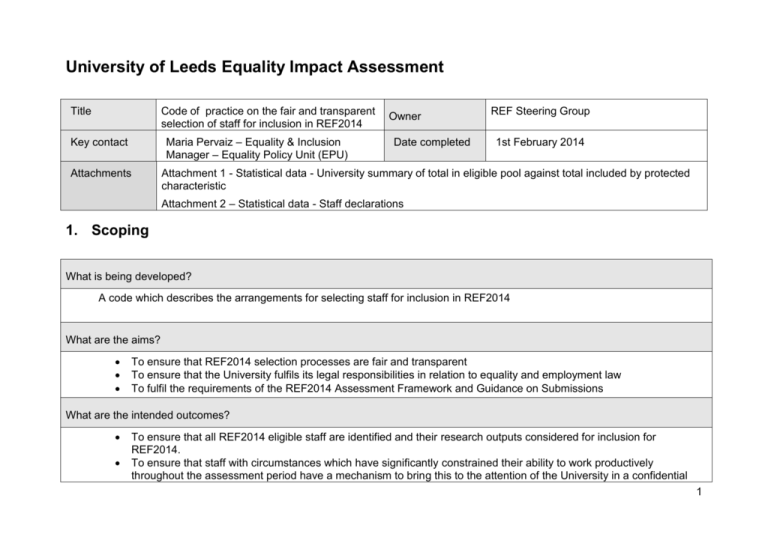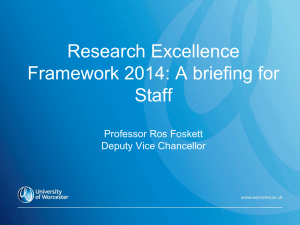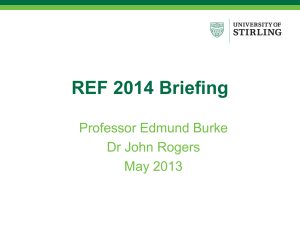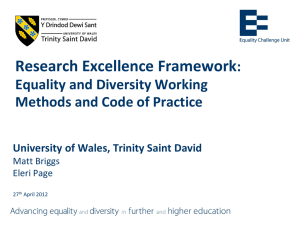REF 2014 Equality Impact Assessment
advertisement

University of Leeds Equality Impact Assessment Title Code of practice on the fair and transparent selection of staff for inclusion in REF2014 Maria Pervaiz – Equality & Inclusion Manager – Equality Policy Unit (EPU) Key contact Attachments Owner Date completed REF Steering Group 1st February 2014 Attachment 1 - Statistical data - University summary of total in eligible pool against total included by protected characteristic Attachment 2 – Statistical data - Staff declarations 1. Scoping What is being developed? A code which describes the arrangements for selecting staff for inclusion in REF2014 What are the aims? To ensure that REF2014 selection processes are fair and transparent To ensure that the University fulfils its legal responsibilities in relation to equality and employment law To fulfil the requirements of the REF2014 Assessment Framework and Guidance on Submissions What are the intended outcomes? To ensure that all REF2014 eligible staff are identified and their research outputs considered for inclusion for REF2014. To ensure that staff with circumstances which have significantly constrained their ability to work productively throughout the assessment period have a mechanism to bring this to the attention of the University in a confidential 1 manner. To ensure that any such circumstances are taken fully into account when considering staff for inclusion in REF2014 eg by assessing whether or not they could be entered with a reduced number of outputs. What are the key stages/activities involved? Identify the eligible pool of staff by reference to REF2014 definitions of eligibility (REF 02.2011, Part 3) Establish base line quality data on the eligible pool by identifying proportions of eligible staff by age, disability, ethnicity, gender, religion and sexual orientation Staff nominate REF candidate publications Review of REF candidate publications Staff invited to declare circumstances which have significantly constrained their ability to work productively throughout the assessment period via a confidential e-mail address Communicate with staff away from the University (due to maternity leave, sickness absence, sabbatical etc) to advise them of the Code and the opportunity to have individual staff circumstances considered Confidential central assessment of the estimated permitted reduction in the number of outputs required for REF2014 (clearlydefined cases assessed by staff in Research and Innovation Service (RIS)/Human Resources (HR); complex cases by centrally convened panel) Proposed reduction in outputs communicated to Unit of Assessment (UOA) leaders, excluding details of the reasons for the reduction Members of staff appeal against initial inclusion decisions Outcome of appeals Inclusion reviews – examine reasons for exclusion of eligible staff, checking in particular for potential undeclared mitigating circumstances, or other forms of potential discrimination For excluded staff, identify actions to support inclusion in future REFs as appropriate Review Code on basis of outcome of appeals, inclusion reviews and data analysis, amend and communicate as appropriate./ Re-advertise arrangements for declaring personal circumstances that may permit submission with a reduction in outputs Finalise submissions Data comparison between the baseline equality data on those eligible for selection, compared to the profile of those in the final submission 2 Who are the key stakeholders? The University All academic staff Deans, Pro-Deans, Heads of School UOA leaders, REF Review and Steering Group Who does this strategy, project or policy affect? All academic staff Deans, Pro-Deans, Heads of School UOA leaders, REF Review and Steering Group Group Details Group Internal: UoL Staff x academic staff External: Visitors Academic Staff x academic staff External: Student Applications Administrative / Management Staff External: Job Applicants Secretarial / Clerical Staff Internal: UoL Students Technical Staff (including technicians, IT support) Internal: Student Applications Craft, Manual, Catering Staff Leeds University Union Details x New academic staff 3 Internal: Job Applicants Staff Unions External: Contractors Other Do the aim, objectives and or key principals of this process have the potential to have a positive or negative effect on any of the following areas? Age Disability Gender Nationality Race Religion or belief Sexual orientation Trans x x x x x x x x Will this strategy, project or policy require a full assessment? Yes 4 2. Assessment A. Evidence Details of the evidence used to establish impact Internal data Data on protected characteristics of academic staff Current REF inclusion status (from recommendations held in Submission Planner) Minimum number of outputs required (as determined by central panel following submission of staff circumstances declaration forms) RAE2008 inclusion information Internal involvement and consultation Code discussed via committee structure (REF Review, Steering Groups, RIB and Senate) UCU – at joint committee meetings and involvement in Inclusion Reviews Open meetings for staff National involvement and Consultation REF2014 guidance and ECU REF-specific guidance Are there any gaps in the evidence? Gaps in information on some characteristics where staff prefer not to provide information. (Note: Current total University staff profile data highlights 7% unknown disability data and 8% unknown ethnicity data. Source University of Leeds PSED data http://www.equality.leeds.ac.uk/university-monitoring-information/introduction/ External data 5 B. Assessing impact Key stages/activities Evidence Data 1st stage/activity 2nd stage/activity Involvement & consultation Action Potential barriers/opportunities to promote equality Actions to mitigate impact/promote equality Refer to profile of staff returned in RAE2008 Proportion of eligible pool by protected characteristics Comparison of equality statistics of staff submitted against total in eligible pool Impact REF Steering Group EPU UCU Improve understanding of the profile of research active staff Continue to improve disclosure rates Examine how this might impact on their personal development and career progression Review opportunities for all academic staff to develop and progress Staff reluctant to come forward to declare personal circumstances; this may be due to concerns about being stigmatised. (The need to declare individual circumstances inevitably affects particular groups more than others, in some cases disclosing previously private conditions / circumstances, such as, caring responsibilities, a miscarriage, an undisclosed disability or mental health condition.) Appropriate communication about staff’s rights in this respect and reassurances of confidentiality and support available UOA leaders communicating effectively with all academic staff 6 C. RISKS Identified Risk Eligible pool is not properly identified and hence eligible staff are overlooked Actions to mitigate: Staff who would be eligible for submission with fewer than 4 publications do not declare circumstances for consideration Outputs are not properly assessed Schools have been asked to check eligibility REF eligibility status visible to all members of staff via Submission Planner (Staff Summary page) Personal emails sent to all current academic and research staff to alert them to the Code and the process for declaring individual circumstances. Email to research staff explains eligibility criteria Promotion of Code via “For staff” website and open meetings for any staff REF-specific training for all involved in recommending selection. Bespoke training provided for the centrallyconvened panel to assess complex circumstances Personal emails to academic and research staff, promotion of code, emphasis on confidentiality Inclusion reviews Appeals process Inclusion reviews of all those not planned for inclusion to ensure the reasons are not discriminatory Appeals process Use the internal submission review process to challenge UOA’s outputs assessment process and encourage to seek external opinion as appropriate 7 3. (a) Action plan (prior to submission date) Action Measure Lead Timescale 1 Code communicated to all academic and research staff (whether or not eligible in the first instance) via a number of communication mechanisms Individual emails sent RIS REF Team Ongoing from late 2011 through to summer 2013 2 Staff invited to return staff declaration form whether or not they wish to claim a reduction in outputs Monitor returns and chase up where necessary RIS REF Team Ongoing from late 2011 through to summer 2013 3 Analysis of the profile of eligible staff by protected characteristic where data available, to form baseline for future analysis Statistics showing proportions of eligible staff by protected characteristic RIS REF Team, EPU and HR January 2013 4 Detailed examination of all cases proposed for non submission to assess the possibility of discrimination Via inclusion reviews Chair of the REF Steering group May – July 2013 5 Careful analysis of straightforward cases for reduction of outputs by RIS/EPU Cases included with reduced outputs RIS/EPU Ongoing until submission date 6 Specialist training for central panel for assessing complex staff circumstances, based on ECU guidelines and case studies All central panel members trained EPU October 2012 7 Assessment of complex cases by central panel to assess whether or not they are eligible for submission with reduced outputs Via complex circumstances panel PVC for Staff and Organisational Effectiveness Ongoing until submission date 8 Comparison of staff profiles by protected characteristic with baseline data for final submission Statistical significance RIS REF Team, EPU and HR November 2013 Campus web announcement Inclusion in staff newsletter 8 (b) Action plan (post submission date) The Pro-Vice-Chancellor for Staff and Organisational Effectiveness sought feedback on the process from the complex circumstances panel, HR, RIS, UOA Leaders and others involved in the process. Following consideration of that feedback, actions have been identified as follows : For each member of staff who was not included but who may wish to reach the standard for inclusion in a future exercise, discuss a personal development plan and other suitable support including mentoring. (Such conversations about non inclusion will need to be handled sensitively where they related to particular issues e.g. international staff, staff returning from long term absence) – LEAD: Head of School supported by HR Feed back to the HEFCE REF Team views relating to circumstances not addressed by the criteria (NB. Only maternity leave which had been taken could be used to justify an automatic reduction in outputs – not miscarriage where maternity leave wasn’t taken; the regulations did not recognise the impact of bereavement as justifying a reduction in outputs, nor where there was a disruption of work with no formal absence) – LEAD: RIS REF Team; Consider ways of capturing information on complex circumstances and their impact as they occur rather than collecting the information as a REF exercise (NB. Some staff were required to revisit distressing circumstances) - LEAD: HR Amend HR policies to ensure that possible REF implications are explained (eg flexible working policy, maternity, adoption leave policy) – LEAD: HR Look into capturing early career research (ECR) status on SAP HR at the time of appointment / contract change once the rules of REF2020 are known – LEAD: HR In preparation for REF 2020, note requirements for a clear timetable, a much clearer communications plan, and the need to have separate systems for straightforward and complex circumstances, taking account of the detailed feedback provided – LEAD: RIS REF Team / HR 9 4. Monitoring and review How will the actions identified be monitored? Through the Equality & Inclusion Governance Framework Who will be responsible for monitoring the Lead person actions? Has the action plan been published? How will this assessment be reviewed? Review date YES, as part of the EIA on the EPU website Through the Equality & Inclusion Governance Framework Annually 10 Attachment 1 University summary of total in eligible pool against total included by protected characteristic Headcount Characteristic Category All All Gender Female Male Total in eligible pool Total included Percentage included Significance 1693 1216 72% 527 362 69% 0.85 1166 854 73% 0.57 55 33 60% 1.03 Disability Disabled Ethnicity BAME 147 102 69% 0.35 White 1269 909 72% 0.08 Buddhist 10 8 80% 0.31 Christian 325 219 67% 0.94 Hindu 11 5 45% 1.03 Jewish 17 13 76% 0.23 Muslim 16 10 63% 0.44 484 344 71% 0.19 Sikh 1 0 0% 0.85 Other 14 9 64% 0.33 Bisexual 16 11 69% 0.15 Gay man 15 8 53% 0.85 Gay woman 11 8 73% 0.04 Heterosexual 718 502 70% 0.60 Religion None Orientation 11 Other Age 5 3 60% 0.31 20 - 29 years 28 18 64% 0.47 30 - 39 years 438 353 81% 2.17 40 - 49 years 609 428 70% 0.45 50 - 59 years 60 years and above 424 282 67% 1.29 194 135 70% 0.37 Note: The data presented is for the pool of REF-eligible Category A staff and shows headcounts (not FTE). The inclusion status reflects the final version of the University's submission to REF. Statistical significance has been assessed on the basis of the magnitude of the quantity |Nobs - Nexp|/Nexp1/2 where Nobs is the observed number and Nexp is the expected number based on the total population. Where the value of this formula is greater than 2 this is considered statistically significant. These instances are highlighted. 12 Attachment 2 Staff declarations Number of forms submitted Total Citing complex circumstances Sub-set associated with eligible staff Sub-set associated with staff who were included in the submission 1152 669 439 73 66 14 Circumstance type Number of individuals included with this circumstance* Junior clinical academic 2 Category C staff primarily employed in NHS 14 Maternity leave 47 Part-time working 66 Early career researcher 216 Complex 14 *includes double counting, eg maternity leave and part-time working 13





